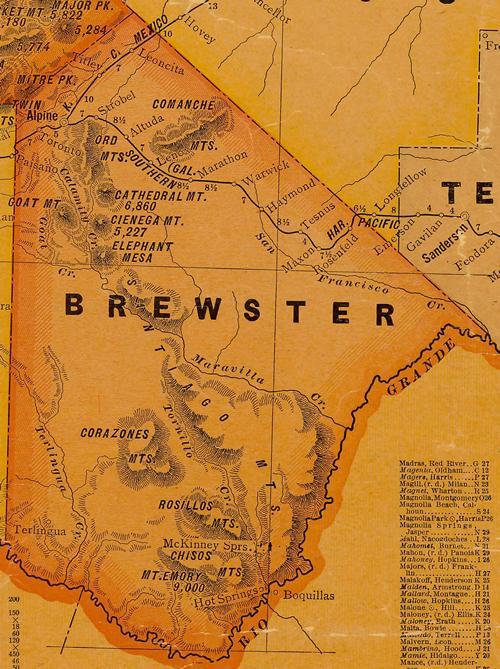|
J.O.
Langford was a young but sickly and despairing man when he made his
way from Midland
to Alpine
in 1909. Langford was born and reared in Mississippi but left there
for Texas because he suffered frequent bouts of malaria in his home
state and thought the arid West
Texas air might be good for him.
In Alpine, Langford listened with great interest as an old man held
forth in a hotel lobby, describing a place where people had bathed
in the water for centuries and were cured of whatever ailed them—stomach
trouble, rheumatism, skin diseases and maybe even malaria. Langford
asked the old man why no one had ever tried to develop the springs,
like they had at Hot Springs, Arkansas.
"Nothing down there but rattlesnakes and bandit Mexicans," the old
man told him. "And it's too far away—that damned country promises
more and gives less than any place I ever saw."
Still, Langford was sold. Langford filed a claim on the land, sight
unseen, under the Homestead Act. Two weeks later, the land was his.
He got it for $1.50 an acre and an understanding that he would live
there continuously for three years and make $300 in improvements.
So Langford, his wife Bessie, and 18-month-old daughter piled everything
they had into a wagon and traveled 11 days to their new home.
"This was a fantastic country, like none I'd ever seen, like no other
I've seen since," Langford wrote in his memoir, Big Bend: A Homesteader's
Story. "And, looking back on it now, I can see that ours was a
fantastic situation. A chronically ill man of thirty-one, a traveling
salesman out of Mississippi, using up his last few dollars to take
his wife and baby to a homestead in the wild, unknown country of the
Texas Big Bend."
One of the unknowns was the fact that a man named Cleofas Natividad,
his wife, and their 10 children were already living at the hot springs
and had been for quite some time. Langford's sympathies were with
Natividad and his family. He decided the deed he held was "a trifling
thing" when compared to the fact that Natividad's family had probably
been living there for generations.
At some point during the 21 days he bathed in the hot springs and
drank the water his malaria vanished. Langford and Natividad constructed
a bathhouse and charged visitors 10 cents per day or $2 for a 21-day
treatment. But, like the naysayer in Alpine had warned, the country
was hard to get to. Langford had to supplement his income by working
as a schoolteacher, a self-taught doctor, and mail carrier. |
|
|
The
Spring and bathhouse ruins
TE Photo |
The hot springs
became a popular gathering spot for people in the area, and a welcome
stop on the road from St. Vincente to Boquillas.
Natividad and the men Langford hired to help him build the bathhouses
shared in the profits and were good friends. Life was pretty good
there at the Hot Springs, and then it wasn't.
Mexican
revolutionary Pancho Villa's bandits
attacked the tiny, isolated communities of Glenn
Springs and Boquillas
on the Rio Grande River in 1916, resulting in several deaths and causing
widespread fear and panic. U.S. President Woodrow Wilson ordered 100,000
National Guard troops to the area, where the army established more
than a dozen "permanent" cavalry camps. The soldiers suggested that
Langford and the others find somewhere else to live until the hostilities
ceased.
Langford and his family moved to El
Paso and stayed there for 14 years. They returned to a land that
had changed but not for the better. The grasslands with grass "as
high as a horse's belly" were gone, grazed down to nubbins as ranchers
tried to exploit high beef prices during World
War I.
Langford built a new store, post office, and cabins to serve overnight
visitors and others who came to "take the waters." The Langfords eventually
sold their property to the state as a donation to Big
Bend National Park.
Visitors to the park today can find evidence of Langford's time there
- ruins of a post office, the original homestead, a motel and other
buildings. The mineral water from the hot springs that cured Langford's
malaria still flows, heated by geothermal processes to 105 degrees,
and people still bathe in it for health and recreation. J.O. Langford
knew a good thing even before he saw it. |
 |
Brewster
County 1920s map showing The Rio Grande, Hot Springs and Boquillas
From Texas state map #10749
Courtesy
Texas General Land Office |
|
|
